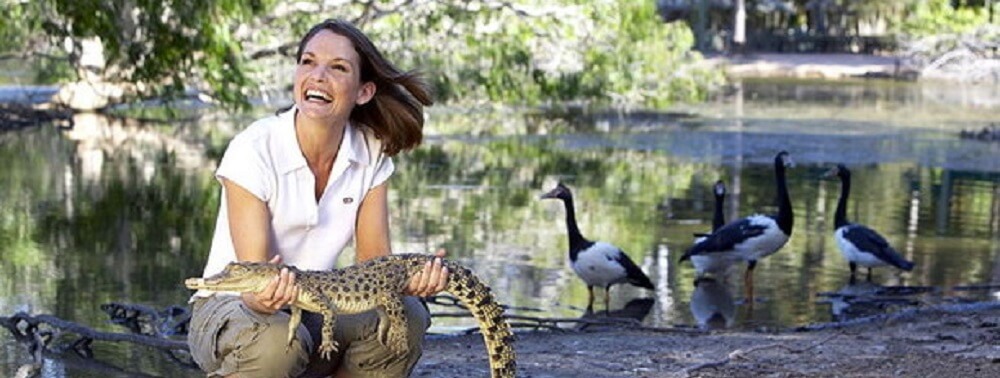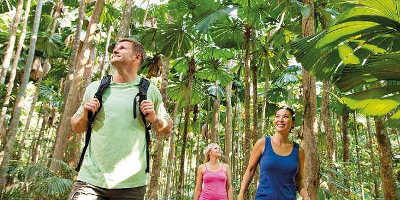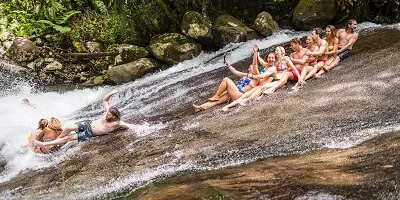
The Salt Water Crocodiles of the Daintree Rainforest
Written by: Cameron Ward
Published: 10/20/2016
Reading time: 4 mins
The Daintree Rainforest is one of Australia’s greatest natural wonders. Promising lush greenery and breath-taking views across the ancient scenery it lures visitors across the globe. Amidst it all, there is a plethora of animal life, including the crocodile – perhaps the most magnificent creature in this region.
Saltwater crocs are huge! Males measure between 5-6 metres, and females come in at a still-impressive 3 metres in length. In the Daintree River, there are thought to be around 70 adult crocodiles. The area is popular for crocodile spotting thanks to its ever-growing population, and proximity to Cairns.
You might think it’s dangerous getting up close and personal with these predators in their natural habitat. However, as crocodile spotting has been an activity since the 70s, the crocs are used to the whirr of boats on their waters.
-
The History of the Saltwater Crocodiles
Saltwater Crocodiles are one of the oldest creatures to walk the planet. They first appeared over 240 million years ago, which was during the Mesozoic Era. While others animals have evolved, crocodiles have mostly had the same features for the last 200 million years.
There are many theories as to why crocodiles have survived so long. One theory explains their cold blood. Dinosaurs were warm-blooded, meaning they had to constantly eat to fuel their metabolisms while they absorbed heat slowly. During the cold and dark conditions following the Yucatan meteor, many warm-blooded creatures did not survive. -
They have a strong link with the Aboriginal Community
Crocodiles have been a prominent part of Australian culture for centuries and have even been a major part of Aboriginal culture. In the past, these creatures were believed to hold bad spirits. They were banished to the saltwater streams as punishment.
-
Saltwater Crocodile Breeding
The crocodiles in the Daintree Rainforest breed during the summer months, also known as the wet season. They lay up to 50 eggs in a compost mound they build themselves and incubate them for around 3 months. The eggs then hatch, producing 20cm long hatchlings that remain with their mother for a few weeks after they are born. Out of all these hatchlings, only 1% of the nest will survive adulthood. The temperature of the eggs will determine their gender. Lower temperatures produce females, whereas a higher temperature results in males.
-
Salt Water Crocodiles and Territory
You don’t want to mess with a saltwater crocodile!
They are extremely territorial, and will attack anything they think may be a threat to them. Being the biggest reptiles on the entire planet, they usually win the territory fights. -
Saltwater Crocodiles Feeding and Hunting
Due to their impressive size, they are at the very top of the food chain. But, amazingly, this isn’t the only reason for them being the top dogs. Their bite is a significant advantage. With 68 deadly teeth, and the ability to exert two tonnes of pressure with a single bite. They trap their prey in their incredibly strong jaws. They snatch up prey in their mouth, and aggressively roll rapidly in the water to remove the limbs of the prey. This is called the death roll.
They can be incredibly sneaky predators, camouflaging themselves in the murky green to brown waters of the tropics. Despite their size, they are quick, usually slowly sneaking up to their prey and darting out of the water before anyone can react. Their endurance is also be incredibly grand, swimming up to 900 kilometres in one go, and lasting long periods without any food.
Sadly, for us, we are on the crocodile’s food menu. Though they typically go after smaller reptiles, fish, birds, and turtles, they have hunt humans before. If a large prey is spotted these crocs won’t back down. There are many incidences of croc attacks throughout the tropics, with occurrences happening every year. Many tourists and locals are caught swimming or standing nearby unsafe, crocodile-infested waters. Due to the high risk, the region has very strict guidelines for seeing crocodiles. With warning signs and brochures listing the unsafe areas. Plus only professional tour companies allowed to purposely seek out crocodiles.
-
Hunting by Humans
Back in the early days, humans hunt them almost to extinction. Luckily the government put a stop to this in 1871, when they put the crocs on the protected species list. Since then, numbers have begun to rise again, and the crocs there are still breeding successfully year after year. Today people still illegally hunt crocodile for their hide. Despite this being a prominent croc-spotting place, experts have described the area as low density because of prolonged hunting over the years.
Related article: Swimming Holes of the Daintree Rainforest.






